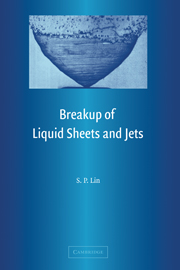Book contents
- Frontmatter
- Contents
- Notation List
- Preface
- 1 Introduction
- 2 Uniform Inviscid Liquid Sheets
- 3 Nonuniform Inviscid Liquid Sheets
- 4 Viscous Liquid Sheet
- 5 Waves on Liquid Sheets
- 6 Phenomena of Jet Breakup
- 7 Inviscid Jets
- 8 A Viscous Jet
- 9 Roles Played by Interfacial Shear
- 10 Annular Liquid Jets
- 11 Nonlinear Capillary Instability of Liquid Jets and Sheets
- 12 Epilogue
- Appendixes
- Author Index
- Subject Index
11 - Nonlinear Capillary Instability of Liquid Jets and Sheets
Published online by Cambridge University Press: 02 December 2009
- Frontmatter
- Contents
- Notation List
- Preface
- 1 Introduction
- 2 Uniform Inviscid Liquid Sheets
- 3 Nonuniform Inviscid Liquid Sheets
- 4 Viscous Liquid Sheet
- 5 Waves on Liquid Sheets
- 6 Phenomena of Jet Breakup
- 7 Inviscid Jets
- 8 A Viscous Jet
- 9 Roles Played by Interfacial Shear
- 10 Annular Liquid Jets
- 11 Nonlinear Capillary Instability of Liquid Jets and Sheets
- 12 Epilogue
- Appendixes
- Author Index
- Subject Index
Summary
In the previous chapters we saw that if We < Q−1, the disturbance of wave numbers smaller than a cut-off wave number is unstable at the onset of instability. The cut-off wave number increases with Q. The capillary force is then shown with linear theories to be responsible for the onset of instability in the presence or absence of fluid viscosities. Subsequent to the onset, the amplitude of disturbances grows rapidly and the neglected nonlinear terms in the linear theory are no longer negligible. Thus the nonlinear evolution of disturbances that lead to the eventual pinching off of drops from a liquid jet can only be described with nonlinear theories. Similarly the pinching off of small droplets from the interface caused by interfacial pressure and shear fluctuations at the onset of instability, when We > Q−1, requires nonlinear theories to describe. Experimental observations of the nonlinear phenomena are presented first.
Experiments
Capillary Pinching
Linear theory predicts that unstable disturbances of different wavelengths grow at different rates and different natural frequencies corresponding to the different wavelengths. Figure 11.1 shows the nonlinear evolution of the disturbances when external sinusoidal forcings are introduced at three different natural frequencies. The forcing frequency for Figure 11.1(a) corresponds to k = 0.683, which is close to the Rayleigh's most amplified disturbance. Figures 11.1(b) and (c) correspond to the cases of lower forcing frequencies corresponding to k = 0.25 and k = 0.075, respectively. The disturbances of wavelengths shorter than that of the fastest growing disturbance appear to grow more slowly as they are convected downstream from the nozzle exit, as predicted by linear theory.
- Type
- Chapter
- Information
- Breakup of Liquid Sheets and Jets , pp. 201 - 222Publisher: Cambridge University PressPrint publication year: 2003



